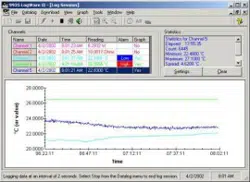Loading ...
Loading ...
Loading ...

The Order option applies only to three curve types:
•
For variable-order polynomial curves, Order is the order of the polyno
-
mial used in curve fitting. A setting of 1 produces a straight line (the same
as a best-fit line); a setting one less than the number of points produces a
curve that passes through every point.
•
For moving-average mid and moving-average end curves, Order is the
range of data points over which moving averages are averaged, beginning
with the first point.
The Granularity scroll bar sets the granularity of all curve types except mov
-
ing-average. The granularity is the number of “steps,” or straight line segments,
making up the curve. Higher values create smoother curves, but require more
drawing time. The default Granularity setting is 50 curve steps, which generally
creates a smooth-looking curve at a high drawing speed. Each click to the left
decreases the number of steps by 2 (to a minimum of 10), and each click to the
right increases the number of steps by 2 (to a maximum of 1000). With spline
curves, you generally need higher granularities than normal—up to 10 times
the number of points in the graph.
Select the colors for each of the statistical lines to display on the graph using
the Color drop-down lists. The selected color for each statistical line applies to
that statistical line for all sets of data.
Select the limit (alarm) lines options to display on the graph using the Limit
Lines options. To display the high alarm line, check the High check box. To
display the low alarm line, check the Low check box.
Note: Changing the low and high limit line settings on this dialog DOES
NOT change the low and high alarm settings entered on the Alarm Set-
tings dialog and therefore does not affect the alarm events options. These
settings are only used to display the alarm lines on the graph. Only
change these settings if absolutely necessary.
Select the line style for the limit (alarm) lines using the Line drop-down list. A
fill pattern can also be selected using the Fill drop-down list. Select the color of
the limit (alarm) lines and the fill pattern using the Color drop-down list.
Select the Fill Opposite check box to fill the area between the High and Low
limit (alarm) lines with the selected pattern. If this option is not checked, the ar
-
eas above the High limit value and below the Low limit value are filled in with
the selected pattern.
Enter the text to appear as a label on the High and Low limit (alarm) lines in
the High Label and Low Label boxes. By default, these labels are set to “High
Alarm” and “Low Alarm” respectively.
Note: Unlike statistical lines, the graph can only display one set of limit
(alarm) lines for all sets of data (traces).
User’s Guide
188
1.888.610.7664 sales@GlobalTestSupply.com
Fluke-Direct.com
Loading ...
Loading ...
Loading ...
